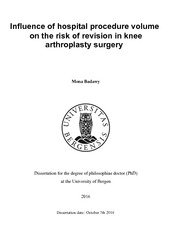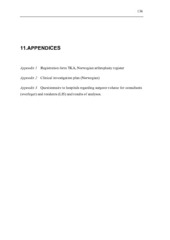| dc.contributor.author | Badawy, Mona | en_US |
| dc.date.accessioned | 2016-10-11T12:01:21Z | |
| dc.date.available | 2016-10-11T12:01:21Z | |
| dc.date.issued | 2016-10-07 | |
| dc.identifier.isbn | 978-82-308-3236-3 | en_US |
| dc.identifier.uri | https://hdl.handle.net/1956/12968 | |
| dc.description | Figures no. 1, 3, 8, 12 and 13 are removed from the version available in BORA due to copyright issues. | |
| dc.description.abstract | The knee is a complex joint consisting of three anatomically and kinematically different compartments; the medial, the lateral and the patellofemoral compartment. When developing painful and disabling osteoarthritis (OA), there are different treatment options. Conservative treatment consisting of pain medication, injection therapy, physiotherapy and exercises can delay or prevent surgical treatment in many patients. However, many OA patients will need knee replacement surgery if all other fails. Most of these patients need a total knee arthroplasty (TKA), but in many cases with isolated unicondylar OA, unicompartmental knee replacement (UKA) is sufficient. Knee replacement surgery is rapidly increasing in Norway and worldwide. Both total knee and unicompartmental knee arthroplasty surgery are technically difficult procedures with multiple possible pitfalls perioperatively. The procedures require thorough knowledge of the bony and soft tissue anatomy and kinematics, as well as proper surgical technique and experience with the implants and concomitant instruments. The purpose of Paper I was to investigate whether there was a correlation between annual hospital procedure volume and the risk of revision in total knee arthroplasty using data from the Norwegian Arthroplasty Register. We found a significantly higher revision risk following total knee arthroplasty in low-volume hospitals in comparison to high-volume hospitals. In Paper II we compared high and low-volume hospitals regarding risk of revision in patients operated with the Oxford III UKA based on data from the NAR. We also investigated possible variations in the reasons for revision. Our interpretation was that higher hospital volumes were beneficial for improved survival of the Oxford III implant. Paper III was an expansion and further development of Paper II, investigating the effect of hospital procedure caseload on the risk of revision upon the usage of Oxford III UKA in the four Nordic countries using data from the Nordic Arthroplasty Register Association database. In this study we used a combination of three different methods of calculating annual hospital procedure volume. Lower volume hospitals had inferior results in all 3 methods of analysis as well as in the combined model with a 3-year moving average estimate. In conclusion, to optimize knee arthroplasty results and to avoid high rates of revision, acceptable procedure volumes should be achieved. TKA patients operated in hospitals performing more than 100 cases per year had a lower risk of revision. UKA patients operated in hospitals performing >40 cases per year had the lowest risk of revision in the NAR, whereas UKA patients in the NARA had a higher risk of revision if operated in hospitals performing less than 25 per year. | en_US |
| dc.language.iso | eng | eng |
| dc.publisher | The University of Bergen | eng |
| dc.relation.haspart | Paper I: Influence of Hospital Volume on Revision Rate After Total Knee Arthroplasty with Cement. Badawy M, Espehaug B, Indrekvam K, Engesæter LE, Havelin LI, Furnes O. J Bone Joint Surg Am. 2013 Sep 18; 95 (18): e131. The article is available at: <a href="http://hdl.handle.net/1956/12961" target="blank">http://hdl.handle.net/1956/12961</a> | en_US |
| dc.relation.haspart | Paper II: Higher Revision Risk for Unicompartmental Knee Arthroplasty in low-volume hospitals. Data from 5 791 cases in the Norwegian Arthroplasty Register. Badawy M, Espehaug B, Indrekvam K, Havelin LI, Furnes O. Acta Orthopaedica 2014; 85 : 342–347. The article is available at: <a href="http://hdl.handle.net/1956/10445" target="blank">http://hdl.handle.net/1956/10445</a> | en_US |
| dc.relation.haspart | Paper III: Oxford Unicompartmental Knee Arthroplasty in the Nordic Countries: effect of hospital caseload on revision rates. 12 986 cases from the Nordic Arthroplasty Register Association, 2000-2012. Badawy M, Fenstad AM, Bartz-Johannessen CA, Indrekvam K, Havelin LI, Robertsson O, W-Dahl A, Eskelinen A, Mäkelä K, Pedersen AB, Schrøder H, Furnes O. The article is not available in BORA. | en_US |
| dc.title | Influence of hospital procedure volume on the risk of revision in knee arthroplasty surgery | en_US |
| dc.type | Doctoral thesis | |
| dc.rights.holder | Copyright the author. All rights reserved | |
| dc.identifier.cristin | 1387911 | |

